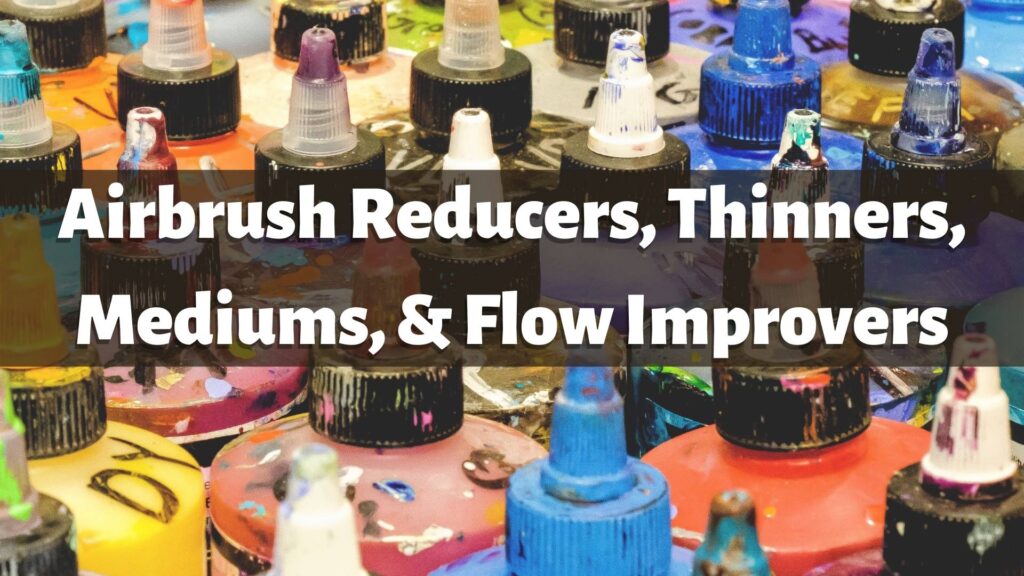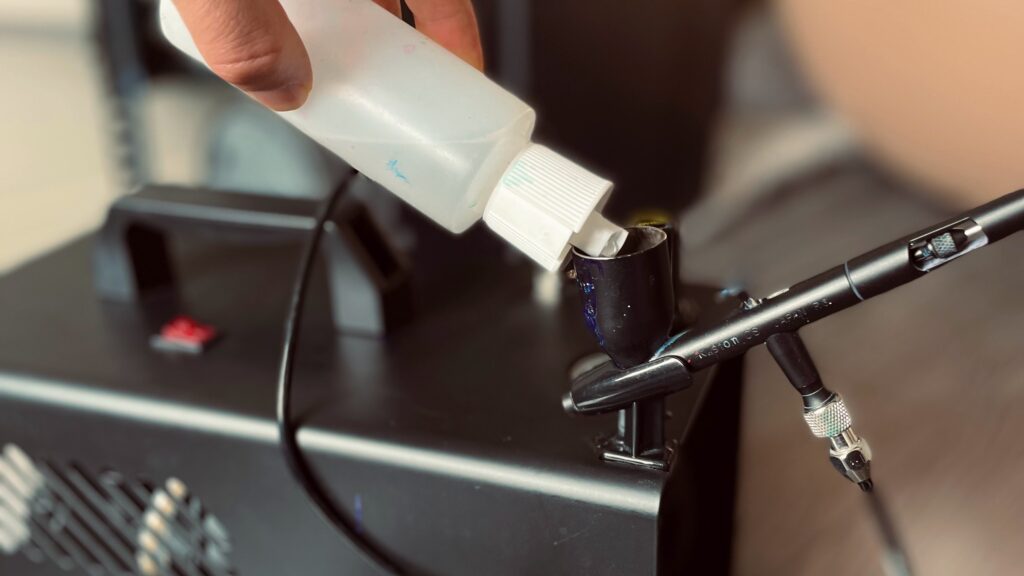Mediums, reducers, thinners, & other additives – the sheer number of different products that you can add to acrylic paint is enough to make your head spin.
I for one was very confused about all the different options, especially when many water-based acrylic airbrush paints are ready to use out of the bottle – why reach for another additive to complicate things?
If you feel the same way, have no fear.
At the end of the day, airbrush additives for acrylic paint are meant to make airbrushing easier and more fun. Just a little airbrush paint additive can go a long way in combating the dreaded clogged nozzle or notorious paint splatter.
This article is meant to demystify the different acrylic airbrush paint additives out there. Read on for a breakdown of what these products are and how to use them.
Here’s a brief breakdown of each of the main acrylic airbrush paint additives:
| Acrylic Airbrush Paint Additive | What’s In It | What it’s Used For |
|---|---|---|
| Airbrush Medium | Resin and Additives | Make acrylic paint airbrush ready |
| Airbrush Reducer | Various Solvents | Thin acrylic airbrush paint |
| Airbrush Thinner | Various Solvents | Thin acrylic airbrush paint |
| Airbrush Flow Improver | Various Solvents and Drying Retarder | Thin acrylic airbrush paint and slow drying time |

How Airbrush Paint is Made
The key difference between airbrush paint and other paint is the consistency that allows it to atomize and flow out of the airbrush nozzle.
Airbrush paint typically has 4 parts:
- Resin/binder
- Pigment
- Solvent
- Additives
In this 4 part mixture, the resin acts as a binding agent that holds the pigments together and determines the paint’s properties once dried.
The pigment gives the paint its color.
The solvent suspends the mixture in a liquid form and allows it to be applied onto the substrate (sprayed out of the airbrush).
Additives are usually included to give the airbrush paint special properties such as sprayability, drying time, or transparency.
Airbrush paint can also be divided into two main categories:
- Water-based Acrylic Paints
- Solvent Based Paints
Water-based acrylic airbrush paint is kind of like your run-of-the-mill everyday paint – it’s usually non-toxic, doesn’t have as many additives, and many can be thinned using water alone – making it relatively simple and easy to use.
Solvent-based airbrush paints use toxic chemicals such as urethane and polyurethane to dissolve the other paint ingredients. They’re typically used in automotive applications because of their ability to bind with metal.
Chemical solvents also allow many more additives to be added into the mix which can change all kinds of properties from application styles to finish. This along with its toxicity makes using solvent-based paint slightly more complex than using their acrylic counterparts.
What is Airbrush Medium and How to Use it
Airbrush medium is made up of a combination of a resin/binder and other additives.
Mediums basically contain all the necessary ingredients you need to make airbrush paint except the pigment.
The most common usage for airbrush medium is to turn a normal acrylic paint into airbrush-ready paint.
Regular acrylic paints can be used in an airbrush if they’re mixed with an airbrush paint medium first. As a general rule, a 1-to-1 ratio mix of acrylic paint to airbrush medium will create the right consistency for use in an airbrush.
When mixing airbrush medium with acrylics, use the 1-to-1 ratio rule as a guide. Sometimes it will be more or sometimes it will be less – the goal is to mix to a consistency that will spray out of the airbrush. Another great rule of thumb is to mix airbrush paint to the consistency of skim milk.
Typically mix at around a 1-to-1 ratio (give or take depending on the original consistency of the paint) – going for the consistency of skim milk.
Since airbrush mediums make up many of the main components of the paint, much of their characteristics will be transferred to the paint. For example, if a glossy airbrush medium is added to an otherwise matte acrylic paint, the mixture will produce a more glossy finish – something to keep in mind as you’re looking to achieve certain effects with your acrylics.
NOTE: Some acrylics are just too thick or the pigments are just too coarse – it doesn’t matter how much airbrush medium you add, they just won’t spray well out of the airbrush nozzle. It’s certainly fun to try and mix your own airbrush paint, but I’ve found that sometimes the cross-over is just too hard to make, and its best to try something else.
NOTE: A side effect of mixing with an airbrush medium is that it will add translucency to the paint. This is a result of just having less pigment in the total volume of paint.
GOLDEN Airbrush Medium is a good option for an airbrush paint medium.
Golden Airbrush Medium
Golden Airbrush Medium is a very good semi-gloss acrylic additive. This medium has a solid resin base that has the ability to turn water-based acrylics into airbrush-ready paints. It even adds a nice flow when combined with airbrush-ready paints – making it a good option as a 2-in-1 flow improver as well. If you’re looking to add a nice semi-gloss base to pretty much anything acrylic, Golden airbrush medium is your pick.
Airbrush Reducer or Airbrush Thinner | Are They the Same?
Whether you’re using airbrush-ready paints or mixing your own acrylics, reducers and thinners are a key part of airbrushing. They both help achieve optimal paint consistency for use in the airbrush.
But if reducers and thinners both do the same thing, what is the difference?
This was a confusing distinction to me for years, so I did some research, and here’s what I found out:
In general, airbrush reducers and airbrush thinners achieve the same effect – thinning the airbrush paint, reducing viscosity, and improving spraying characteristics. Airbrush reducers and airbrush thinners contain various solvents that react with the paint’s resin to create a uniform mixture that sprays well out of the airbrush.
Simply put, airbrush thinner and airbrush reducer are basically the same thing with different branding – each brand has its own “secret formula.” The ingredients can range from water-based with glycol ether, alcohol-based, or acetone.
Because of the chemical makeup, it’s always important to check the SDS (safety data sheet) of the product before using it in your airbrush.
NOTE: Often, the product is made to bind with the brand’s corresponding paints. Therefore, not all reducers and thinners will work the same with your paint.
Reducer should be used at a ratio of about 1:10 reducer to airbrush paint.
One of the best airbrush reducers that I’ve tried over the years is the Wicked Colors Airbrush Reducer.
Wicked Colors Airbrush Reducer
Best All Around Airbrush for Automotive Paint
Wicked Colors Airbrush Reducer is one of the most well-rounded water-based reducers on the market. It’s made by one of the premium airbrush brands, Createx Colors so you know you’re getting a good product. This reducer works wonders on pretty much any water-based acrylic airbrush paint out there, making it a versatile option – thinning effectively without adding excessive transparency.
What is Airbrush Flow Improver and What is it Used For?
Airbrush flow improver has a thinning component but also an anti drying component. This makes it flow out of the gun better and helps avoid tip dry and clogged nozzles.
Sounds a lot like airbrush reducer/thinner doesn’t it? Here’s the difference:
Airbrush thinner and airbrush flow improver are the same in that they both thin airbrush paint. However, airbrush flow improver also extends paint drying time – this added effect further improves paint flow, avoids tip dry, and prevents nozzle clogging.
Even though flow improver technically has some thinning characteristics, its main use is to make the paint work better in your airbrush. This means that the consistency of flow improver will be a little thicker than thinners/reducers – much closer to that of an airbrush medium.
Since the focus is on improving flow, a combination of flow improver and reducer can actually work wonders for your airbrushing.
Just like airbrush reducer, a 10% flow improver to paint ratio is a good rule of thumb. You can then add more flow improver or some reducer to really dial in the paint consistency.
Flow improver often contains similar paint solvents such as glycol ethers which are somewhat toxic – always check the SDS to see if an airbrush mask is needed.
Vallejo Airbrush Flow Improver is a very popular product that works well in water-based acrylic airbrush paint.
Vallejo Airbrush Flow Improver
Vallejo Airbrush Flow Improver is one of the best flow improvers you can get for airbrushing with acrylics. Add a few drops of this to your paint mix and it will glide out of the nozzle like a slip-and-slide on a hot summer’s day. Just as advertised, it slows down the drying time and really cuts down on tip dry. For a good, all-purpose acrylic paint additive, Vallejo Flow Improver covers a lot of bases.
How to Thin Acrylic Airbrush Paint with Water
Many acrylic paints can be thinned with water for use in the airbrush. H2O is a good thinning option for two main reasons:
- Its cheap
- Its non-toxic
When you’re blowing a thick stream of airbrush paint, a fat cloud of whatever’s in your airbrush can form in the room. Unfortunately, many paint additives like reducers and thinners have toxic properties.
This is where an airbrushing mask or extra ventilation may be in order. But even then, water is the safest option to thin acrylic airbrush paint instead of risking it with toxic alternatives.
You can also use non-toxic acrylics thinned with water for airbrush bodypainting because it’s completely safe for use on the skin.
ARTICLE: The Top 5 Best Airbrush Paints for Bodypainting
NOTE: Excessive thinning of acrylic paint with water can add unwanted translucency. Unlike other airbrush thinners and additives, water doesn’t have fancy chemical solvents. This means that water risks over thinning the paint easier which leads to pooling, beading, and drips.
Ultimately, airbrush mediums, thinners, and flow improvers will achieve better performance with acrylic paint in your airbrush. But for a quick and safe alternative, plain old water will get the job done and thin your paint.
How to Use Acrylic Airbrush Paint Additives Together

Since acrylic airbrush paint additives all do something slightly different, you can mix and match to achieve some cool effects.
As you progress in an airbrush project, you’re likely to use a variety of paints for different purposes – sometimes spraying a wide fill pattern and sometimes going in with small detail work.
Different brands of paint will behave differently in your airbrush (maybe you like a certain shade of blue in one brand vs. another). Even within brands, different colors have different pigments and consistencies (white is often super thick).
To deal with different paint profiles and uses, I personally like to have a little flow improver and reducer within arms reach at all times.
If you’re using an already transparent, thin consistency paint for a base coat, there is no reason to reduce it. In fact, a little airbrush medium may be in order to make it more opaque.
However, if you’re attempting to use a thick opaque color for some fine details, a healthy addition of airbrush flow improver and reducer can make this possible.
NOTE: Always start with a little additive and work your way up – you can always add more reducer, but once the paint is over-reduced, you can’t take it out.
Airbrushing with paint additives is fun because it adds depth to your artwork. I look at the vast choices in mediums, thinners, reducers, and flow improvers and I see a world of opportunity for experimentation.
You will always produce your best artwork when you’re having fun. Additives are there to get your paint consistency just right. Although slightly intimidating at first, a little trial and error will expose the perfect mixture for your taste – with water-based acrylics, you really can’t go wrong.






This has been the most helpful thing I have come across to understand all the vocabulary and supplies around painting. All the videos start with the assumption you understand what you covered. I will continue to return to this article as my skills grow as a most indispensable tool to understand the craft of airbrushing and painting in general.
Thnk you …
Hey William glad to hear about the value you got from the article! Cheers, Matt